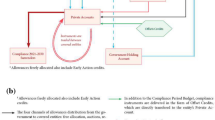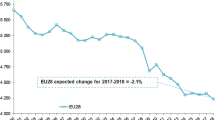Abstract
Global climate change mitigation needs all countries’ efforts under the United Nations Framework Convention on Climate Change’s guideline of equity and common but differentiated responsibilities and respective capabilities. The medium-to-long term regional emissions pathways simulated by integrated assessment models with global mitigation costs minimized to achieve the 2 °C goal might be very different from the regional emissions allowances allocated based on effort-sharing principles. Global carbon trading is a cost-effective mechanism to bridge the gap. Insight of previous papers has mainly focused on the impact of a single effort-sharing scheme on global carbon market, while this study attempts to explore the scale and benefit of global carbon market under different effort-sharing principles to achieve the 2 °C goal, with the application of a consistent modeling framework, consisting of an integrated assessment model and an effort-sharing platform. The results indicate that scale of global carbon market would be highly related with the effort-sharing principles. The global trading volumes would change from 1.8 Gigatons (Gt) carbon dioxide (CO2) to over 12 GtCO2 per year and largely peak between 2030 and 2040 under different kinds of effort-sharing principles. Correspondingly, annual global finance flows in the carbon market would increase gradually and reach the scale of hundreds of billions United States (US) dollars since 2020. Global carbon market would lower the abatement costs of developed countries, and the overall global abatement costs would drop by 0.4–2.6% during 2011–2050. The developing countries would not only acquire revenues from global carbon trading but also be provided with an opportunity to accelerate their domestic low-carbon energy transformation, local environmental improvement, job creation, and economic development. Linking national and regional carbon markets to develop global carbon market will be critical to maximize the utility of the market mechanism.







Similar content being viewed by others
References
Alexeeva V, Anger N (2016) The globalization of the carbon market: welfare and competitiveness effects of linking emissions trading schemes. Mitig Adapt Strateg Glob Chang 21(6):905–930. https://doi.org/10.1007/s11027-014-9631-y
Baer P, Harte J, Haya B, Herzog A, Holdren J, Hultman N, Raymond L (2000) Equity and greenhouse gas responsibility. Science 289(5488):2287. https://doi.org/10.1126/science.289.5488.2287
Baer P, Kartha S, Athanasiou T, Kemp-Benedict E (2009) The greenhouse development rights framework: drawing attention to inequality within nations in the global climate policy debate. Dev Chang 40(6):1121–1138. https://doi.org/10.1111/j.1467-7660.2009.01614.x
Böhringer C, Welsch H (2006) Burden sharing in greenhouse: egalitarianism and sovereignty reconciled. Appl Econ 38(9):981–996. https://doi.org/10.1080/00036840500399453
CDIAC (2017) Retrieved from: http://cdiac.ess-dive.lbl.gov/trends/emis/tre_glob_2014.html
Chen W, Wu Z, He J, Gao P, Xu S (2007) Carbon emission control strategies for China: a comparative study with partial and general equilibrium versions of the China MARKAL model. Energy 32(1):59–72. https://doi.org/10.1016/j.energy.2006.01.018
Clarke L, Kim S, Edmonds J, Dooley J (2009) CO2 emissions mitigation and technological advance: an updated analysis of advanced technology scenarios. Pacific Northwest National Laboratory, Washington, DC
Clarke L, Jiang K, Akimoto K, Babiker M, Blanford G, Fisher-Vanden K et al (2014) Assessing transformation pathways. Climate Change 2014: mitigation of climate change. Contribution of Working Group III to the Fifth Assessment Report of the Intergovernmental Panel on Climate Change
den Elzen M, Lucas P (2005) The FAIR model: a tool to analyse environmental and costs implications of climate regimes. Environ Model Assess 10(2):115–134. https://doi.org/10.1007/s10666-005-4647-z
den Elzen M, Berk M, Lucas P et al (2006) Multi-stage; a rule-based evolution of future commitments under the climate change convention. Int Environ Agreements: Politics Law Econ 6(1):1–28. https://doi.org/10.1007/s10784-004-5645-3
den Elzen M, Beltran A, Hof A, van Ruijven B, van Vliet J (2013) Reduction targets and abatement costs of developing countries resulting from global and developed countries’ reduction targets by 2050. Mitig Adapt Strateg Glob Chang 18(4):491–512. https://doi.org/10.1007/s11027-012-9371-9
Edmonds J, Clarke L, Lurz J, Wise M (2008) Stabilizing CO2 concentrations with incomplete international cooperation. Clim Pol 8(4):355–376. https://doi.org/10.3763/cpol.2007.0469
Fawcett A, Iyer G, Clarke L, Edmonds J, Hultman N, Mcjeon H et al (2015) Can Paris pledges avert severe climate change? Science 350(6265):1168–1169. https://doi.org/10.1126/science.aad5761
GCAM wiki (2017) Retrieved from: http://jgcri.github.io/gcam-doc/aglu.html
GCI (Global Commons Institute) (2005) GCI Briefing: contraction-convergence. http://www.gci.org.uk/
Glomsrød S, Wei T, Alfsen K (2013) Pledges for climate mitigation: the effects of the Copenhagen accord on CO2 emissions and mitigation costs. Mitig Adapt Strateg Glob Chang 18(5):619–636. https://doi.org/10.1007/s11027-012-9378-2
Hof A, den Elzen M, Admiraal A, Roelfsema M, Gernaat D, Vuuren D (2017) Global and regional abatement costs of nationally determined contributions (NDCs) and of enhanced action to levels well below 2°C and 1.5°C. Environ Sci Pol 71:30–40. https://doi.org/10.1016/j.envsci.2017.02.008
Höhne N, den Elzen M, Weiss M (2006) Common but differentiated convergence (CDC): a new conceptual approach to long-term climate policy. Clim Pol 6(2):181–199. https://doi.org/10.1080/14693062.2006.9685594
Höhne N, den Elzen M, Escalante D (2014) Regional GHG reduction targets based on effort sharing: a comparison of studies. Clim Pol 14(1):122–147. https://doi.org/10.1080/14693062.2014.849452
Huang W, Chen W, Anandarajah G (2017) The role of technology diffusion in a decarbonizing world to limit global warming to well below 2 °C: an assessment with application of Global TIMES model. Appl Energ 208:291–301
ICAP (2017) Emissions trading worldwide: status report 2017. ICAP, Berlin
Jacoby H, Babiker M, Paltsev S, Reilly J (2008) Sharing the burden of GHG reductions. MIT Joint Program on the Science and Policy of Global Change. http://18.7.29.232/handle/1721.1/44625
Li W, Jia Z (2017) Carbon tax, emission trading, or the mixed policy: which is the most effective strategy for climate change mitigation in China? Mitig Adapt Strateg Glob Chang 22(6):973–992. https://doi.org/10.1007/s11027-016-9710-3
Lucas P, Shukla P, Chen WY, van Ruijven B, Dhar S, den Elzen M, van Vuuren D (2013) Implications of the international reduction pledges on long-term energy system changes and costs in China and India. Energ Policy 63:1032–1041. https://doi.org/10.1016/j.enpol.2013.09.026
Mcjeon H, Edmonds J, Bauer N, Clark L, Fisher B, Flannery B et al (2014) Limited impact on decadal-scale climate change from increased use of natural gas. Nature 514(7523):482–485. https://doi.org/10.1038/nature13837
Onigkeit J, Anger N, Brouns B (2009) Fairness aspects of linking the European emissions trading scheme under a long-term stabilization scenario for CO2 concentration. Mitig Adapt Strateg Glob Chang 14(5):477–494. https://doi.org/10.1007/s11027-009-9177-6
Pan X, Teng F, Wang G (2014) Sharing emission space at an equitable basis: allocation scheme based on the equal cumulative emission per capita principle. Appl Energy 113:1810–1818. https://doi.org/10.1016/j.apenergy.2013.07.021
Pan X, Chen W, Clarke L, Wang L, Liu G (2017a) China’s energy system transformation towards the 2 °C goal: implications of different effort-sharing principles. Energ Policy 103:116–126
Pan X, den Elzen M, Höhne N, Teng F, Wang L (2017b) Exploring fair and ambitious mitigation contributions under the Paris agreement goals. Environ Sci Pol 74:49–56. https://doi.org/10.1016/j.envsci.2017.04.020
Qi T, Weng Y (2016) Economic impacts of an international carbon market in achieving the INDC targets. Energy 109:886–893. https://doi.org/10.1016/j.energy.2016.05.081
Raupach M, Davis S, Peters G et al (2014) Sharing a quota on cumulative carbon emissions. Nat Clim Chang 4(10):873–879. https://doi.org/10.1038/nclimate2384
Ringius L, Torvanger A, Holtsmark B (1998) Can multi-criteria rules fairly distribute climate burdens—OECD results from three burden sharing rules. Energ Policy 26(10):777–793. https://doi.org/10.1016/S0301-4215(98)00032-9
Rive N, Torvanger A, Fuglestvedt J (2006) Climate agreements based on responsibility for global warming: periodic updating, policy choices, and regional costs. Glob Environ Chang 16(2):182–194. https://doi.org/10.1016/j.gloenvcha.2006.01.002
Rogelj J, Luderer G, Pietzcker R et al (2015) Energy system transformations for limiting end-of-century warming to below 1.5 °C. Nat Clim Chang 5(6):519–527. https://doi.org/10.1038/nclimate2572
UNFCCC (1992) United Nations general assembly. United Nations Framework Convention on Climate Change, Paris
UNFCCC (2015) Adoption of the Paris agreement (1/CP.21). United Nations framework convention on climate change, Bonn
United Nations, Department of Economic and Social Affairs (2016) World population prospects. http://esa.un.org/wpp/unpp/panel_population.htm
Wang L, Patel P, Yu S, Liu B, Mcleod J, Clarke L, Chen W (2016) Win–win strategies to promote air pollutant control policies and non-fossil energy target regulation in China. Appl Energy 163:244–253. https://doi.org/10.1016/j.apenergy.2015.10.189
Wang L, Chen W, Zhang H, Ma D (2017) Dynamic equity carbon permit allocation scheme to limit global warming to two degrees. Mitig Adapt Strateg Glob Chang 22(4):609–628. https://doi.org/10.1007/s11027-015-9690-8
World Bank (2015) http://data.worldbank.org/indicator/NY.GDP.MKTP.KD. Cited 05 Apr 2015
World Bank, Ecofys, Vivid Economics (2017) State and trends of carbon pricing 2017, by World Bank, Washington, DC. https://doi.org/10.1596/978-1-4648-1218-7
World Resources Institute (WRI), CAIT 2.0 (2015) Climate analysis indicators tool: WRI’s climate data explorer. World Resources Institute, Washington, DC. http://cait2.wri.org. Cited 05 Jan 2015
Yin X, Chen W, Eom J, Clarke L, Kim S, Patel P et al (2015) China’s transportation energy consumption and CO2, emissions from a global perspective. Energ Policy 82(1):233–248. https://doi.org/10.1016/j.enpol.2015.03.021
Funding
This research is supported by National Natural Science Foundation of China (71690243) and Ministry of Science and Technology of China (2012BAC20B01). Pan X. would also like to thank National Natural Science Foundation of China (71703167).
Author information
Authors and Affiliations
Corresponding author
Rights and permissions
About this article
Cite this article
Wang, L., Chen, W., Pan, X. et al. Scale and benefit of global carbon markets under the 2 °C goal: integrated modeling and an effort-sharing platform. Mitig Adapt Strateg Glob Change 23, 1207–1223 (2018). https://doi.org/10.1007/s11027-018-9781-4
Received:
Accepted:
Published:
Issue Date:
DOI: https://doi.org/10.1007/s11027-018-9781-4




